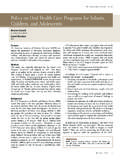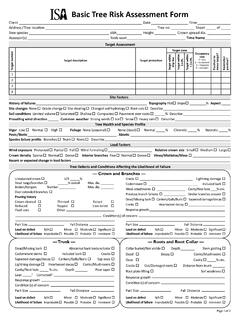Transcription of 25 THERFNTCN5 M Caries-risk Assessment and Management …
1 Official but Unformatted Caries-risk Assessment and Management for Infants, Children, and Adolescents Latest Revision 2022 Abstract This best practice reviews Caries-risk Assessment and patient care pathways for pediatric patients. Caries-related topics presented include Caries-risk Assessment , active surveillance, caries prevention, sealants, fluoride, diet, radiology, and non-restorative treatment. Caries-risk Assessment forms are organized by age: 0-5 years and 6 years old, incorporating three factor categories (social/behavioral/ medical, clinical, and protective factors) and disease indicators appropriate for the patient age. Each factor category lists specific conditions to be graded yes if applicable, with the answers tallied to render a Caries-risk Assessment score of high, moderate, or low. The care Management pathway presents clinical care options beyond surgical or restorative choices and promotes individualized treatment regimens dependent on patient age, compliance with preventive strategies, and other appropriate strategies.
2 Caries Management forms also are organized by age: 0-5 years and 6 years old, addressing risk categories of high, moderate, and low, based on treatment categories of diagnostics, interventions (fluoride, diet counseling, sealants), and restorative care. Caries-risk Assessment and clinical Management pathways allow for customized periodicity, diagnostic, preventive, and restorative care for infants, children, adolescents, and individuals with special needs. This document was developed through a collaborative effort of the American Academy of Pediatric Dentistry Councils on Clinical Affairs and Scientific Affairs to offer updated information and recommendations regarding Assessment of caries risk and risk-based Management protocols. KEYWORDS: Caries-risk Assessment , CARIES PREVENTION, CLINICAL Management PATHWAYS, DENTAL SEALANTS, FLUORIDE Abbreviation AAPD: American Academy of Pediatric Dentistry Official but Unformatted Purpose The American Academy of Pediatric Dentistry (AAPD) recognizes that Caries-risk Assessment and caries Management protocols, also called care pathways, can assist clinicians with decisions regarding treatment based upon child s age, caries risk, and patient compliance and are essential elements of contemporary clinical care for infants, children, and adolescents.
3 These recommendations are intended to educate healthcare providers and other interested parties on the Assessment of caries risk in contemporary pediatric dentistry and aid in clinical decision-making regarding evidence- and risk-based diagnostic, fluoride, dietary, and restorative protocols. Methods This document was developed by the Council on Clinical Affairs, adopted in 20021, and last revised in 20192. To update this document, an electronic search was conducted of publications from 2012 to 2021 that included systematic reviews/meta-analyses or reports from expert panels, clinical guidelines, and other relevant reviews using the terms: caries risk Assessment AND diet, sealants, fluoride, radiology, non-restorative treatment, active surveillance, caries prevention. Five hundred ninety-two articles met these criteria.
4 Papers for review were chosen from this list and from references within selected articles. When data did not appear sufficient or were inconclusive, recommendations were based upon expert and/or consensus opinion by experienced researchers and clinicians. Background Caries-risk Assessment Risk Assessment procedures used in medical practice generally have sufficient data to accurately quantitate a person s disease susceptibility and allow for preventive measures. However, in dentistry there are limited sufficiently validated multivariate screening tools to determine which children are at a higher risk for dental ,4 Two caries risk Assessment tools, namely the Cariogram5 and CAMBRA tools6, have been validated in clinical trials and clinical outcomes studies. Several other published Caries-risk Assessment tools utilize similar components but have not been clinically ,7 Nevertheless, Caries-risk Assessment : 1.
5 Fosters the treatment of the disease process instead of treating the outcome of the disease. 2. allows an understanding of the disease factors for a specific patient and aids in individualizing preventive discussions. 3. individualizes, selects, and determines frequency of preventive and restorative treatment for a patient. 4. anticipates caries progression or stabilization. Official but Unformatted 5. determines different treatment plan options and tailors the specific individualized self- Management goals. Caries-risk Assessment is part of a comprehensive treatment plan approach based on age of the child, starting with the age one visit. Caries-risk Assessment models currently involve a combination of factors including diet, fluoride exposure, a susceptible host, and microflora that interplay with a variety of social, cultural, and behavioral Caries-risk Assessment is the determination of the likelihood of the increased incidence of caries ( , new cavitated or incipient lesions) during a certain time period9,10 or the likelihood that there will be a change in the size or activity of lesions already present.
6 With the ability to detect caries in its earliest stages ( , non-cavitated or white spot lesions), health care providers can help prevent Caries risk factors are variables that are thought to cause the disease directly ( , microflora) or have been shown useful in predicting it ( , life-time poverty, low health literacy) and include those variables that may be considered protective factors. The most-used caries risk factors include low salivary flow, visible plaque on teeth, high frequency sugar consumption, presence of appliance in the mouth, health challenges, socio-demographic factors, access to care, and cariogenic The presence of caries lesions, either non-cavitated or cavitated, also has been shown in numerous studies to be a strong indicator of caries risk. Clinical observation of existing caries lesions or restorations recently placed because of such lesions are best thought of as disease indicators, rather than risk factors, since these lesions do not cause the disease directly or indirectly but, very importantly, indicate the presence of the factors that cause the disease.
7 Protective factors in caries risk include a child s receiving optimally-fluoridated water, having teeth brushed daily with fluoridated toothpaste, receiving topical fluoride from a health professional, and having regular dental ,12 Some limitations with the risk factors include the following: Past caries experience is not particularly useful in young children and activity of lesions may be more important than number of lesions. Low salivary flow is difficult to measure and may not be relevant in young Frequent sugar consumption is hard to quantitate. Socio-demographic factors are just a proxy for various exposures/behaviors which may affect caries risk. Predictive ability of various risk factors across the life span and how risk changes with age have not been Official but Unformatted Genome-level risk factors may account for substantial variations in caries Risk Assessment tools can aid in the identification of specific behaviors or risk factors for each individual and allow dentists and other health care professionals to become more actively involved in identifying and referring high-risk children.
8 Tables 1 and 2 incorporate available evidence into practical tools to assist dental practitioners, physicians, and other non-dental health care providers in assessing levels of risk for caries development in infants, children, and adolescents. As new evidence emerges, these tools can be refined to provide greater predictably of caries in children prior to disease initiation. Furthermore, the evolution of Caries-risk Assessment tools and care pathways can assist in providing evidence for and justifying periodicity of services, modification of third-party involvement in the delivery of dental services, and quality of care with outcomes Assessment to address limited resources and work-force issues. Care pathways for caries Management Care pathways are documents designed to assist in clinical decision-making; they provide criteria regarding diagnosis and treatment and lead to recommended courses of The pathways are based on evidence from current peer-reviewed literature and the considered judgment of expert panels, as well as clinical experience of practitioners.
9 Care pathways for caries Management in children aged 0-2 and 3-5 years old were first introduced in Care pathways are updated frequently as new technologies and evidence develop. Historically, the Management of dental caries was based on the notion that it was a progressive disease that eventually destroyed the tooth unless there was surgical/restorative intervention. Decisions for intervention often were learned from unstandardized dental school instruction and then refined by clinicians over years of practice. It is now known that surgical intervention of dental caries alone does not stop the disease process. Additionally, many lesions do not progress, and tooth restorations have a finite longevity. Therefore, modern Management of dental caries should be more conservative and includes early detection of non-cavitated lesions, identification of an individual s risk for caries progression, understanding of the disease process for that individual, and active surveillance to apply preventive measures and monitor carefully for signs of arrest or progression.
10 Care pathways for children further refine the decisions concerning individualized treatment and treatment thresholds based on a specific patient s risk levels, age, and compliance with preventive strategies (Tables 3 and 4). Such clinical pathways yield greater probability of success, fewer com- plications, and more efficient use of resources than less standardized Official but Unformatted Content of the present caries Management protocol is based on results of systematic reviews and expert panel recommendations that provide better understanding of and recommendations for diagnostic, preventive, and restorative treatments. Recommendations for the use of fluoridated toothpaste are based on four systematic reviews17-20, dietary fluoride supplements are based on the Centers for Disease Control and Prevention s fluoride guidelines21, professionally-applied and prescription strength home-use topical fluoride are based on two systematic reviews19,22, and the use of silver diamine fluoride to arrest caries lesions also is based on two systematic reviews23,24.














